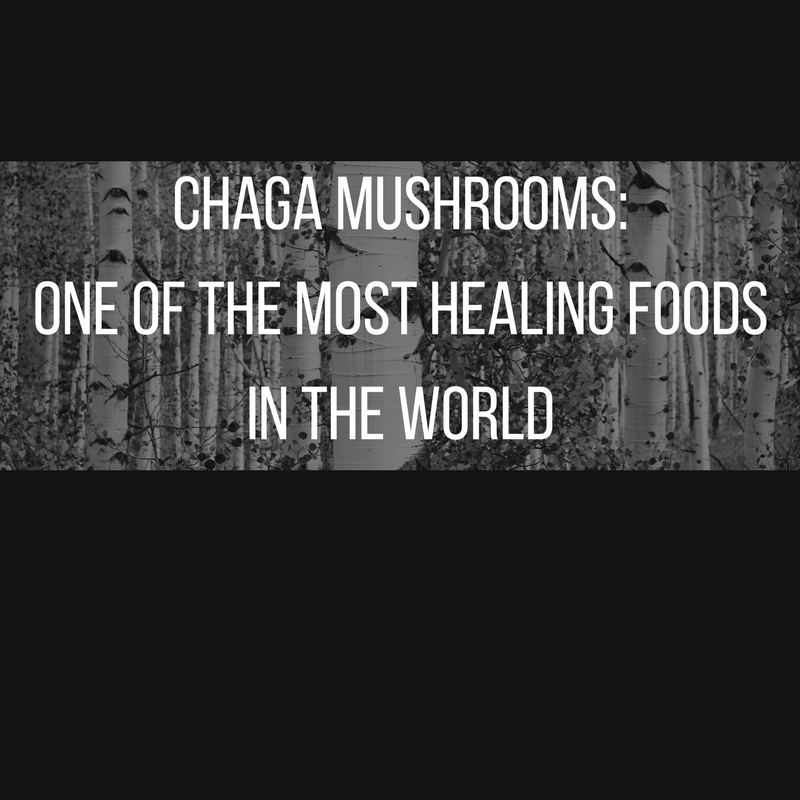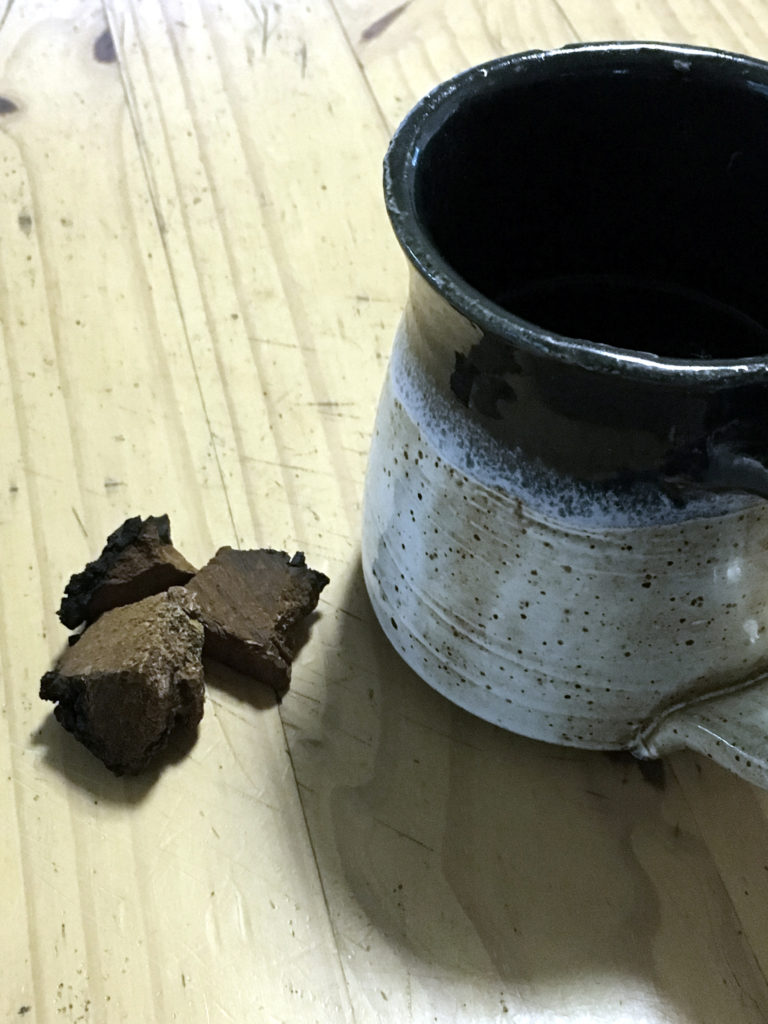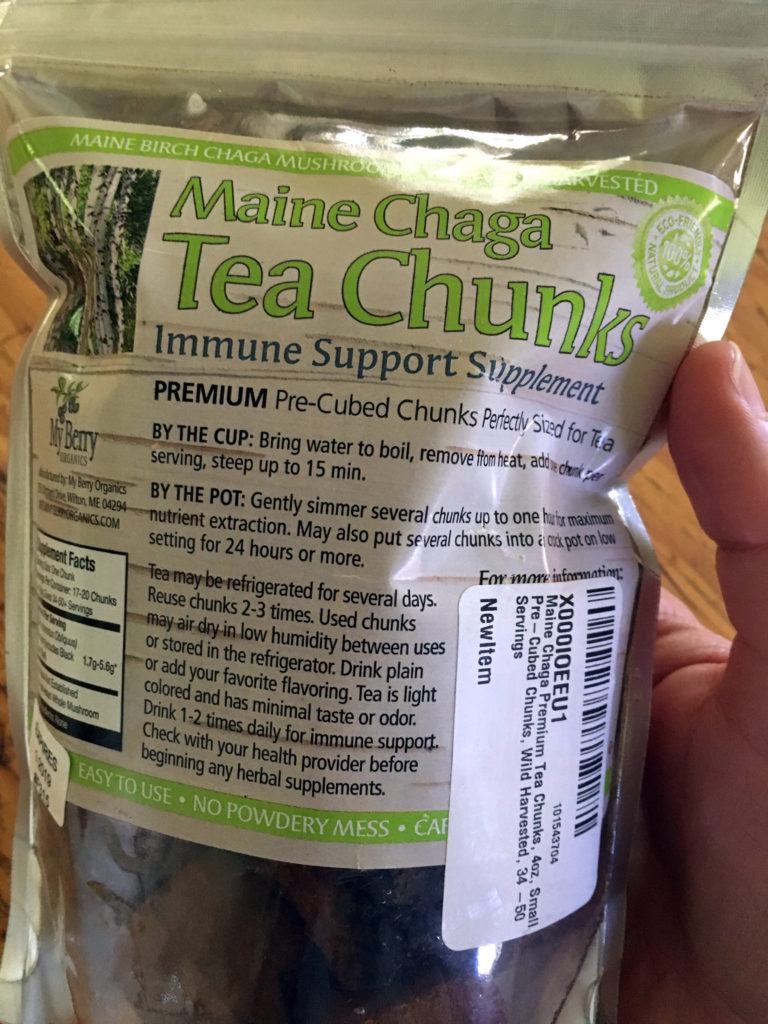…so say the Chinese!
I have a wonderful post lined up for today. One of my most awesome readers, Rolly, over at (Fireside Rolly, Rolly Chabot Books, and at Weebly) contacted me a little while back and asked that since I loved tea so much, if I had tried chaga mushroom tea.
First, Rolly, thank you SO MUCH for this question! To all readers: if you have a question or want to see something that isn’t on the site, yet, please just send me an email and I’ll look forward to hearing from you.
Before I delve into the subject of chagas, here’s some full disclosure:
Mushrooms and I haven’t always gotten along – at least when it came to liking the taste. In fact, pretty much it’s in the last six months have I begun to change my taste preferences toward this food staple.
Growing up, I never cared for the taste, texture or aroma. I shied away from anything containing mushrooms: the thought of eating something squishy and fungus-y was less than appetizing to me.
But, as I’m making the transition from a vegetarian diet to a plant-based diet (as part of the LIFE Project), I have already found that if prepared well, mushrooms are really delicious.Their taste and texture is earthy and I’ve come to enjoy the terra-scented aroma they emit when I’m cooking them.
This is probably one big reason I’d never heard of chaga mushrooms. Ha!
But I’m infinitely grateful for Rolly’s suggestion that I try these.
They have a sweet, but not overpowering taste similar to vanilla when you make tea from them!
Rolly shared with me about his experiences finding chaga mushrooms, which then led to him sharing incredible stories of his adventures up in the Canadian wilderness and how chagas have impacted that.
I have great respect for Rolly and he carries such wisdom in his words and stories. After hearing so much about chaga from Rolly, I ordered some myself and wanted to share with others about this incredible mushroom with which to make tea.
Disclaimer: Always check with your health care provider before consuming herbal supplements.

Large chaga mushroom chunks Source: Tad Montgomery & Associates, TadMontgomery.com [CC BY-SA 3.0], via Wikimedia Commons
About Chaga
Up in Canada, it grows on white birch trees and Rolly has his own stand of trees from which he can retrieve these mushrooms.
It grows in colder climates on the trunks of birch trees.
I’ve heard of it growing in the US (primarily in the northeast), Canada, Russia and other Far Eastern places.
Communities in China, and Russia, and the First Nations people in Canada as well as Native American Indians in the US have long since consumed this tea, but is only beginning to gain recognition in the wider world community for its almost miraculous-seeming healing powers.
In fact, the Chinese report that it’s one of the most beneficial foods on earth and has been used in traditional Chinese medicine for centuries!
On the tree itself, it looks like it’s parasitic – like a burl on the tree trunk – with a dark outer layer called the sclerotium.
In fact, that black mass of chaga is the mycelium (the vegetative part of the fungus that forms whitish filaments) that is feeding off of the birch tree.
Chaga and birch have a symbiotic relationship, however.
The tree benefits from the chaga because it grows where a the tree was weakened or injured (such as from a branch breaking) and “covers” the wound, preventing other organisms from infesting the tree.
When you harvest the chaga, the inside of it almost looks and feels like wood. It seems hard like wood, too.
You’d have no idea that this stuff is incredibly beneficial to consume or that it’s even a mushroom if you didn’t know what you were looking for!
But, harvesting requires that the mushroom be broken into chunks to dry, or you can make an extract from it by soaking the chunks in alcohol.
This helps to break down the chitin (hard protein cell walls).
Making the tea or the extract further breaks the chitin down, allowing for its medicinal use.
Some people break it down further by grinding it into a powder to add to recipes or smoothies.
Benefits of Chaga Mushrooms
Just what is it about chaga mushrooms that makes it special?
It is known for its incredible health benefits, of course.
In fact, Rolly shared with me about a friend who was diagnosed with cancer eight years ago who started drinking chaga tea, and has been cancer-free ever since.
Powerful stuff!
As I began researching the benefits of chaga tea, I couldn’t believe the long list of benefits that this mushroom provides.
Chaga mushrooms help with the following:
- Regulate the human immune system (if it’s too active, it stabilizes it and if it’s not active enough, it stimlates it)
- Can relieve inflammation
- Purifiy the blood
- Adaptogenic, meaning it can help prevent and cure cancer
- Can be used as a pain reliever
- Regulate cell production in the body
- An incredible antioxidant from the dark melanin in the mushroom’s outer layer – higher than any superfood. It effectively stops oxidation in cells because of its high level of SOD, or superoxide dismutase.
- Help protect skin and hair from damage.
- Help improve LDL blood cholesterol levels
- They contain a wide array of phytonutrients, such as polysaccharides, sterols, and more
- They’re high in amino acids, which are the essential building blocks of protein
- Natural nergy booster
- May help with Lyme disease
Making Chaga Tea
There are several ways to make chaga.
By the Pot:
Rolly’s Method (using chunks):
- You want to be sure to find as pure and wild-harvested chaga chunks as you can find.
- Place several chunks in a pot and simmer (never boil) for a few hours.
- Save the chunks, as they can be reused up to 3 times.
- The tea will be dark brown to black and then you can drink as is – it will have a woodsy taste that is a little sweet.
- You can add sweetener if you’d like. You will feel a natural an pure boost of energy, but not like with caffeine.
Powder Method:
More than a few sources on the web have chaga in powder form. In fact, in one source I’ve used for this post, the author likes to grind chaga into his own powder.
Over at his website, the author reports that he likes to take 5-6 tbsp of the ground powder and simmer for 4-6 hours, always keeping the temperature lower than 180 degrees.
Crock pot Method (using chunks):
Put several chunks into a crock pot and cover with water. Set on low and you can leave it for 24 hours or longer.
By the cup (using one chunk):
Still, you can make a cup at a time (this is what I have done so far).
Use water that is steaming, but not boiling and pour over one chaga tea-sized chunk.
Steep 15 minutes or longer. If you make a cup using this method, the tea tends to be lighter with a less pungent taste.
The chunks are great because afterward, you can reuse them. You can air-dry them out in the open or put into the fridge.
Though I’ve only made chaga tea by the cup, I can’t wait to try Rolly’s method. Since Rolly has so much experience with chaga, I really want to try simmering the chunks for awhile.
Ordering Your Own Chaga Mushrooms
The Annanda Chaga site I’ve listed below in the references section sells the chunks in Canada. I wanted to order from there as they really seem to know their stuff, but the shipping charges were high (not the fault of the site – country to country shipping can get expensive).
So, I ordered Maine Chaga Tea Chunks from “My Berry Organics” located in the US. I made sure they were 100% wild harvested, locally sourced whose company also follows sustainable harvesting practices. I found them on Amazon. Here are the links to their website and to their product on Amazon (not an endorsement; no commissions from these links):
Chaga Mushroom Tea Chunks – Amazon
My Berry Organics (which links back to Amazon for purchase)
Make it a Contemplative, Mindful Experience!
Drinking tea is a meditative act in itself. It forces you (in a good way) to slow down, take slow sips and reflect.
But, did you know that at any time, you can turn it into a meditative experience?
Brew your tea according to the methods above.
Then, take your cup and go find a quiet spot. Turn off the television, music or whatever noise that may be distracting.
Sit upright and slowly focus on your breathing. Take several deep breaths. Let your mind naturally slow down.
Take a sip of the warm tea. Note the earthy, sweet taste. Let it trickle down your throat.
Repeat this until you have finished your cup. As thoughts come to your mind, let them simmer and dissolve gently. Always gently.
Once your are finished, don’t forget to be grateful for the gift of the chaga tea and water that have nourished you.




I had not heard of this tea from a mushroom called Chaga before.. But I expect my daughter has, We make Kumbucha tea from a culture.. I am sure you have heard of that.. But you do add loads of sugar in that to help fermentation.. And I would make many flavours using fruit teas etc.. But I intuitively went off it for some reason.. Maybe because of all the Sugar I saw I was adding. Sugar is not good as we know..
So I was very interested in this. And will ask my daughter to look into sourcing some for me.. As She will get things over the internet for me.. I am still old fashioned in many ways as to not buy on line.. 🙂
So enjoyed your video 👍 🙂 And how you made the ritual of making and drinking Chaga into a meditation.. So calming..
Wishing you a perfect and peaceful week in your busy working days ahead..
Lots of Love and Hugs..
Sue 🙂 <3
Sue – hehe, as I type, I’m sipping it and it’s *wonderful*. I’d bet your daughter has. 🙂 As for Kombucha, you know, I tried to like it, but I couldn’t stomach it. I think it’s an acquired taste, but I just couldn’t do it. Hehe. But I can totally see where you might be put off from adding sugar – even if it gets used in the fermentation process. Yes…sugar. Back in 05-06, I gave up refined sugar and tried to go vegetarian and organic. But, I did it so suddenly, I couldn’t stick with it for that long – I think I did it all wrong because our grocery bill doubled! Hehe. I’ve learned a lot since then and though I eat some “refined sugar” candy (i.e. regular candy) from time to time, for the most part, I’ve phased it out slowly. Eh…I let myself slip up. I do have a sweet tooth, but I find that when I eat naturally sweet things like sweet potatoes and trail mix, for example, I don’t crave sugar. I try to eat high-value foods now, ones that I know are nourishing. It may be a bit of a challenge to source some near you, but then again, it may not be – chagas do well in northern colder climates. It was a little challenging finding US-based sites; the Canadian one was phenomenal.
Aww…shucks. Thank you for your sweet words in the video. And I love making it into a meditation – any time I can, I’m up for it. So calming…and I hope you have a wonderful week, too. Sending you love, hugs and light. xo
I actually do like mushrooms to eat normally. But never thought to use them for making tea to drink. Seriously, think you know how I do enjoy drinking tea. So, now I am going to have to give Chaga mushrooms a try for my for my own tea drinking experience. Thanks for sharing about them here, as well as the benefits, too. Happy Monday and once again sending some extra hugs your way now!! xoxo <3
Janine – YES! You love tea, too! I’m going to have to do well to remember that. I hadn’t heard of chagas before Rolly enlightened me, but as I type this, I’m drinking a cup. It’s good stuff! I’ve only had it a week, but I’ll have to remember to come back and update what I’ve personally felt over the long term. 🙂 I hope you’ve had a great Monday and sending you extra, EXTRA hugs, too. <3 xo
Good information, Lil Sis! I’ll pass this along to Bev; I have no doubt that she will try it. Me? I make no promises…it sounds way too healthy for me. LOL Kidding, kind of….I’m such a stick-in-the-mud when it comes to trying new foods and drinks. How’s this? I promise to try it if Bev finds some. 🙂 Have a stupendous week, my dear friend.
Big Bro, you just go right ahead and tell Bev – I bet she’ll have you drinking that stuff right out of the shipping box! 😀 As far as trying new foods and drinks…really? You? Trying new things? I hadn’t pegged you for a non-adventurous eater…Mr. Quail Eggs. 😉 Hehe. If Bev can find some, LEMME KNOW! I’d love to hear. Have a fantastic week yourself! Hugs!
Thanks for sharing Cynthia. I’ve heard of chaga mushrooms, but not tried them. Maybe I will. Thanks. 🙂
Brad – that’s great! Chagas are yummmmmy! Do give them a try and I’d love to know what you think. 🙂
Thank you for sharing this, Cynthia 🙂
I have never heard about this tea before, but I will give it a chance too.
Now I do drink Matcha and I’m very happy for your post about same.
Wish you a new beautiful week.
Irene – thank you for stopping by! You’ve been drinking matcha!? That’s *awesome* – I LOVE that stuff. I love it with coconut milk and organic stevia lately. And, of course, I do like chaga tea with some organic stevia, too. 🙂 Hehe. Aww, sending you hugs and I hope you have a wonderful, wonderful week! xo
Hi Cynthia and all new Chaga folks…
Great article Cynthia, very well done, informative knowledge is the essences of enjoying this amazing product. It is articles such as yours that will spur others to try it. Once the benefits are felt and experienced others will share.
Congratulations on award winning research and explanation of this natural product.
Hugs
Rolly
Rolly – I was just about to email you the link when I saw your comment come in. 🙂 Thank you for EVERYTHING that you shared – your knowledge and enthusiasm about chaga convinced me that I must try! I’m so glad I did! I hope others do try it. It’s one of those things that will help increase an appreciation for nature’s gifts and trying new things.
So grateful for your comments and questions and I hope you have a fantastic week! Sending hugs back, CS
Awww I loved seeing this post about tea and Rolly – 2 of my favorites! Of course you Cindy are another fave of mine ♥ Rolly has talked to me too about Chaga mushrooms and it’s been on my to-do list to make the tea. Thanks for pointing out reputable places to get the chunks as I think I would prefer that way over the powder form for making the beverage. You’re a bundle of information, sweet friend! Such a healthy drink!
Christy – aww, thank you! Rolly’s great! ANd YOU are a fave of MINE! 💝 Rolly’s told you about chaga, too? Consider yourself honored! He’s got incredible information, doesn’t he? And yeah, that Annanda Chaga site is Canada-based, so you should have no problem with shipping. 🙂 I definitely go for the chunks and not the powder myself – I trust what Rolly says. You, too are a bundle of information and love and I just love seeing your sweet words! I hope you have a wonderful week! xo 🔆
My 13 Year old daughter Mercedes is doing a Science fair Research Project on Chaga – She is looking for experiences – Health benefits… She is Anishinabe and Indigenous and will be connecting our traditional ways of knowing and human experience. She is looking to the cyber world for help.
Kichi Migwech – Thank you so very much!
Celine – thank you for coming by and commenting. How awesome that I was able to help with your daughter’s science project. 🙂 I do enjoy those chagas and I honor my Native American ancestors and relations by helping to share some things I learn along the way. I loved your “thank you.” Come back and ask any questions if you need. If I don’t know the answer, I’ll find out. And I would love to learn more about the Anishinabe.